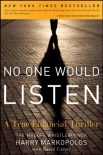No One Would Listen: A True Financial Thriller by Harry Markopolos (rainbow fish read aloud .txt) 📗

- Author: Harry Markopolos
Book online «No One Would Listen: A True Financial Thriller by Harry Markopolos (rainbow fish read aloud .txt) 📗». Author Harry Markopolos
Red Flag # 7:The counter-party credit exposures for UBS and Merrill would be too large for these firms credit departments to approve. The SEC should ask BM for trade tickets showing he has traded OTC options thru these two firms. Then the SEC should visit the firms’ OTC derivatives desks, talk the to heads of trading and ask to see BM’s trade tickets. Then ask the director of operations to verify the tickets and ask to see the inventory of all of the stock and listed options hedging the OTC puts and calls. If these firms can’t show you the off setting hedged positions then they are assisting BM as part of a conspiracy to commit fraud. If any other brokerage firms equity derivatives desk is engaged in a conspiracy to cover for BM, then this scandal will be a doozy when it hits the financial press but at least investors would have firms with deep pockets to sue.
Red Flag # 8:OTC options are more expensive to trade than listed options. You have to pay extra for the customization features and secrecy offered by OTC options. Trading in the size of $20-$50 billion per month would be impossible and the bid-ask spreads would be so wide as to preclude earning any profit whatsoever. These BrokerlDealers would need to offset their short OTC index put option exposure to a falling stock market by hedging out their short put option risk by either buying listed put options or selling short index futures and the derivatives markets are not deep and liquid enough to accomplish this without paying a penalty in prohibitively expensive transaction costs.
Red Flag # 9: Extensive and voluminous paperwork would be required to keep track of and clear each OTC trade. Plus, why aren’t Goldman, Sachs and Citigroup involved in handling BM’s order flow? Both Goldman and Citigroup are a lot larger in the OTC derivatives markets than UBS or Merrill Lynch.
E. My experience with split-strike conversion trades is that the best a good manager is likely to obtain using the strategy marketed by the third-party FOF’s is T-bills less management fees. And, if the stock market is down by more than 2%, the return from this strategy will range from a high of zero return to a low of a few percent depending upon your put’s cost and how far out-of-the-money it is.
F. In 2000 I ran a regression of BM’s hedge fund returns using the performance data from Fairfield Sentry Limited. BM had a .06 correlation to the equity market’s return which confirms the .06 Beta that Fairfield Sentry Limited lists in its return numbers.
Red Flag # 10:It is mathematically impossible for a strategy using index call options and index put options to have such a low correlation to the market where its returns are supposedly being generated from. This makes no sense! The strategy depicted retains 100% of the single-stock downside risk since they own only index put options and not single stock put options. Therefore if one or more stocks in their portfolio were to tank on bad news, BM’s index put would offer little protection and their portfolio should feel the pain. However, BM’s performance numbers show only 7 extremely small losses during 14½ years and these numbers are too good to be true. The largest one month loss was only - 55 basis points (-0.55%) or just over one-half of one percent! And BM never had more than a one month losing streak! Either BM is the world’s best stock and options manager that the SEC and the investing public has never heard of or he’s a fraud. You would have to figure that at some point BM owned a WorldCom, Enron, GM or HealthSouth in their portfolio when bad or really bad news came out and caused these stocks to drop like a rock.
8. Red Flag # 11: Two press articles, which came to print well after my initial May 1999 presentation to the SEC, do doubt Bernie Madoff’s returns and they are:
a. The May 7, 2001 edition of Barron’s, in an article entitled, “Don’t Ask, Don’t Tell; Bernie Madoff is so secretetive, he even asks his investors to keep mum,” written by Erin Arvedlund, published an expose about Bernie Madoff a few years ago with no resulting investigation by any regulators. Ms. Arvedlund has since left Barron’s. I have attached a copy of the Barrons’ article which lists numerous red flags.
b. Michael Ocrant, formerly a reporter for MARHedge visited Bernie Madoff’s offices and wrote a very negative article entitled, “Madoff tops charts; skeptics ask how,” that doubted the source of BM’s returns. This article was published on May 1, 2001 and is attached [see Appendix A of this book]. Mr. Ocrant has graciously agreed to cooperate fully with the SEC and awaits the SEC’s telephone call to arrange a meeting. The SEC should contact him directly. Michael Ocrant is currently serving as the Director of Alternative Investments; Institutional Investor; New York, NY 10001; Telephone #orEmail:
9. Fund of funds with whom I have spoken to that have BM in their stable of funds continually brag about their returns and how they are generated thanks to BM’s access to his broker-dealer’s access to order flow. They





Comments (0)